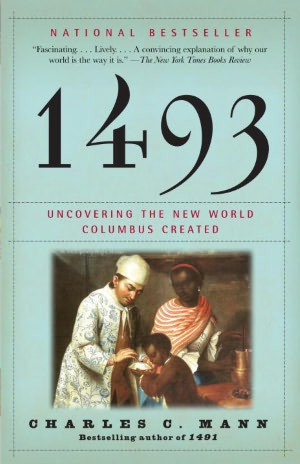Chapter 8 of 1493: Uncovering the New World Columbus Created (by Charles C. Mann) describes how Mexico became a "crazy soup" of people from America, Africa, Europe and Asia, with Mexico City becoming the first cosmopolitan city. Branches of the Homo sapiens species that had not been in contact for many thousands of years came together surprisingly quickly after Columbus' voyage. The Colombian Exchange included an exchange of DNA among humans whose ancestors had been isolated from each other for millennia.
I was brought up in the American school system that emphasized the European immigration to the Americas. Therefore I was not surprised to learn that between 1500 and 1840, some 3.4 million Europeans immigrated to the Americans. I was very surprised to read that 11.7 million Africans came to the Americas in the same time. The early post-Colombian migration was primarily a migration of Africans to the Americas!
Mann describes the development of the sugar industry in the Americas as one reason for the massive African migration. The crop had migrated from its original point of domestication in New Guinea to the Muslim controlled Holy Land by the time of the Crusades. Europeans were fascinated by the crop, but could not successfully commercialize it in mainland Europe. The Spanish and Portuguese however were able to grow sugarcane in islands off the coast of Africa. They introduced the slavery in the islands to meet the demand for labor in the sugar plantations.
The Spanish found that sugarcane grew well in the Caribbean, the gulf coast of Central America and the north coast of South America and the Portuguese discovered it grew well in Brazil. They also discovered that sugar created its own demand -- the more they shipped to Europe, the higher the prices for sugar appeared to go. Since Europeans did not survive the tropical diseases in the mosquito plagued areas suitable for sugarcane and Africans did, large numbers of Africans were brought to the Americas to work the sugar plantations, The came as slaves. (Of course, they also eventually came to work for the British and French.)
As described in earlier posts on 1493, the Spanish established a trade between Mexico and Asia, trading American silver for Asian silk and porcelain. Mann writes that between 50,000 and 100,000 Asians migrated via this Pacific trade route to Mexico. The came mostly from the Philippines, China and Japan.
 |
| Artists conception of Tenochtitlan as Cortes might first have found it. |
Mann does not stress the point, but the American Indians were tribal. He writes that what we think of as the Aztec Empire was actually a coalition of three tribes. Cortes was able to overcome that coalition with a coalition of different tribes which he led with his small be well armed band. The Inca Empire similarly included people from many tribes. One must assume that after the Spanish conquest of the Incas, there must have been some flow of South American Indians into the Mexican highlands. In any case, the Indians must have perceived themselves as a multi-ethnic part of the larger multi-ethnic society.
All these groups interbred. A complex system of categories grew up describing people by the ethnicity of their ancestors. I myself have seen 16th century church records in a Mexican village recording the births of blancos (European), indios (Indians), mestizos (mixed European and Indian parentage), mulatos (mixed European and African parentage) and zambos (mixed African and Indian parentage). Eventually the Spanish developed a more complex system of social categories, with Peninsulares (Spanish immigrants) at the top and Criollos next, followed by many classes of mixed ancestry, not to mention the pure Indians, Africans and Asians.
Mexico City, built on the capital of the Aztec Empire which had been one of the largest cities in the world, became a dramatically cosmopolitan city -- the prototype for cities on all continents that developed after Columbus. Surprisingly, I have found that there still remain social categories in Mexico based on ethnic identity, hundreds of years after Europeans, Africans and Asians started havign children with native Americans and probably thousands of years of people from different tribes marrying and having children.
- Rubber and how it went global.
- What Happened when the potato and its pests reached Europe
- What happened when American food crops got to China
- The Silver Trade after 1493
- The Little Ice Age Might Have Been Global Warming in Reverse
- The Globalization of Trade in Psychoactive Substances
- A Thought About Mosquito Borne Diseases

No comments:
Post a Comment